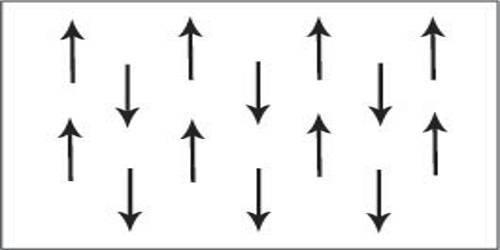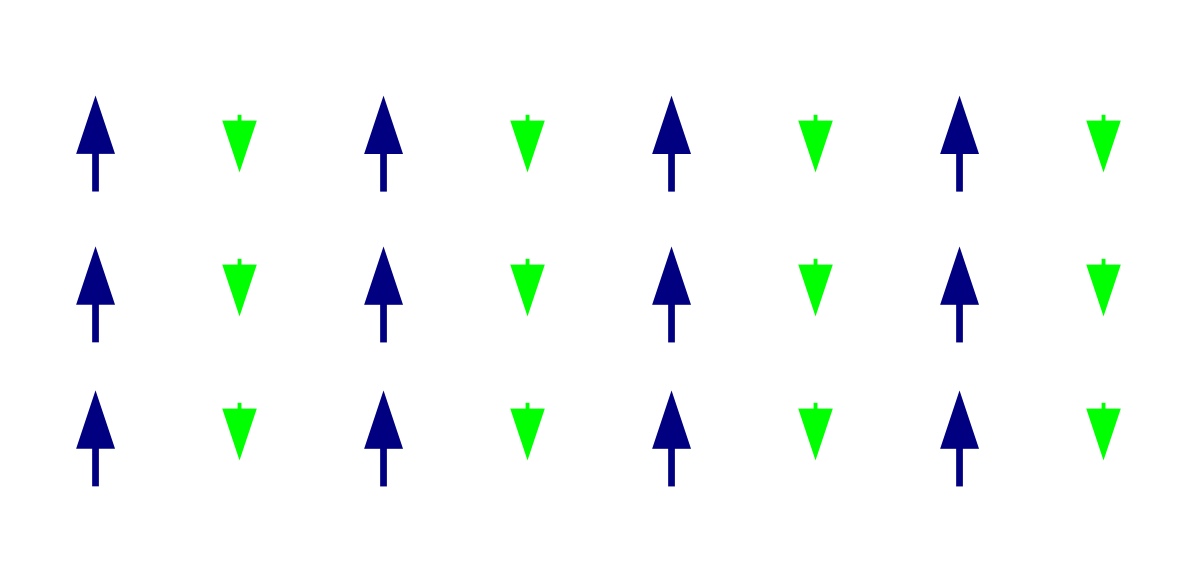Ferro Magnetism
Ferromagnetic materials are also characterized by being made up of clusters of 10 17 to 10 21 atoms called magnetic domains, that all have their magnetic moments pointing in the same direction. The moments of the domains is random in unmagnetized materials, and point in the same direction in magnetized materials.
Ferromagnetism is a property of a material in which particles called magnetic moments organize parallel to one another when there is a magnetic field. These particles remain in place even when the magnet is taken away. Magnetism occurs on an atomic level, with the field having a direct affect on the electrons in an atom. Electrons that spin in. Definition of ferromagnetic: of or relating to substances with an abnormally high magnetic permeability, a definite saturation point, and appreciable residual magnetism and hysteresis Other Words from ferromagnetic Example Sentences Learn More about ferromagnetic Other Words from ferromagnetic.
Iron, nickel, cobalt and some of the rare earths (gadolinium, dysprosium) exhibit a unique magnetic behavior which is called ferromagnetism because iron (ferrum in Latin) is the most common and most dramatic example. Samarium and neodymium in alloys with cobalt have been used to fabricate very strong rare-earth magnets.
Ferromagnetic materials exhibit a long-range ordering phenomenon at the atomic level which causes the unpaired electron spins to line up parallel with each other in a region called a domain. Within the domain, the magnetic field is intense, but in a bulk sample the material will usually be unmagnetized because the many domains will themselves be randomly oriented with respect to one another. Ferromagnetism manifests itself in the fact that a small externally imposed magnetic field, say from a solenoid, can cause the magnetic domains to line up with each other and the material is said to be magnetized. The driving magnetic field will then be increased by a large factor which is usually expressed as a relative permeability for the material. There are many practical applications of ferromagnetic materials, such as the electromagnet.

Ferromagnets will tend to stay magnetized to some extent after being subjected to an external magnetic field. This tendency to 'remember their magnetic history' is called hysteresis. The fraction of the saturation magnetization which is retained when the driving field is removed is called the remanence of the material, and is an important factor in permanent magnets.

All ferromagnets have a maximum temperature where the ferromagnetic property disappears as a result of thermal agitation. This temperature is called the Curie temperature.
Ferromagntic materials will respond mechanically to an impressed magnetic field, changing length slightly in the direction of the applied field. This property, called magnetostriction, leads to the familiar hum of transformers as they respond mechanically to 60 Hz AC voltages.

| Magnetic properties of solids | Table of magnetic properties |
| Table of Curie temperatures |
Key Difference – Ferromagnetism vs Antiferromagnetism
Ferromagnetism and antiferromagnetism are two of the five classifications of magnetic properties. The other three are diamagnetism, paramagnetism, and ferrimagnetism. The key difference between ferromagnetism and antiferromagnetism is thatferromagnetism can be found in materials having their magnetic domains aligned into the same direction whereas antiferromagnetism can be found in materials having their magnetic domains aligned in opposite directions.
A magnetic domain or an atomic moment is a region in which the magnetic fields of atoms are grouped together and aligned. Ferromagnetic materials are attracted to an external magnetic field and have a net magnetic moment. But antiferromagnetic materials have a zero net magnetic moment.
CONTENTS
1. Overview and Key Difference
2. What is Ferromagnetism
3. What is Antiferromagnetism
4. Side by Side Comparison – Ferromagnetism vs Antiferromagnetism in Tabular Form
5. Summary
What is Ferromagnetism?
Ferromagnetism is the presence of magnetic domains which are aligned into the same direction in magnetic materials. The most common examples of ferromagnetic materials are metals such as iron, nickel, cobalt and their metal alloys. The magnetic domains of these metals have strong interactions due to the electronic exchange between atoms. These strong interactions cause the alignment of magnetic domains in the same direction. Ferromagnetic materials exhibit parallel alignment of magnetic domains which results in the magnetization of the materials even in the absence of an external magnetic field.
Figure 1: Order of Magnetic Domains in Ferromagnetic Materials
Spontaneous Magnetization

The spontaneous magnetization is the magnetization of a material even in the absence of an external magnetic field. The magnitude of this magnetization is affected by the spin magnetic moment of electrons present in the ferromagnetic material.
High Curie Temperature
Ferromagnetism Mri
Curie temperature is the temperature at which the spontaneous magnetization starts to vanish. For ferromagnetic materials, this occurs at a high temperature.
What is Antiferromagnetism

Antiferromagnetism is the presence of magnetic domains that are aligned in opposite directions in magnetic materials. These opposite magnetic domains have equal magnetic moments which are canceled out (since they are in opposite directions). This makes the net moment of the material zero. This type of materials is known as antiferromagnetic materials.
Figure 2: Order of Magnetic Domains in Antiferromagnetic Materials
Common examples of antiferromagnetic materials can be found from transition metal oxides such as manganese oxide (MnO).
The Neel temperature (or the magnetic ordering temperature) is the temperature at which an antiferromagnetic material begins to be converted into a paramagnetic material. At this temperature, the thermal energy provided is large enough to break down the alignment of magnetic domains present in the material.
What is the Difference Between Ferromagnetism and Antiferromagnetism?
Ferromagnetism vs Antiferromagnetism | |
| Ferromagnetism is the presence of magnetic domains that are aligned in the same direction in magnetic materials. | Antiferromagnetism is the presence of magnetic domains that are aligned in opposite directions in magnetic materials. |
| Alignment of Magnetic Domains | |
| The magnetic domains of ferromagnetic materials are aligned in the same direction. | The magnetic domains of antiferromagnetic materials are aligned in opposite directions. |
| Net Magnetic Moment | |
| Ferromagnetic materials have a value for net magnetic moment. | Antiferromagnetic materials have a zero net magnetic moment. |
| Examples | |
| Examples of ferromagnetic materials include metals such as iron, nickel, cobalt and their metal alloys. | Examples of antiferromagnetic materials include transition metal oxides. |
Ferromagnetismus
Summary – Ferromagnetism vs Antiferromagnetism
Materials can be divided into several groups based on their magnetic properties. Ferromagnetic and antiferromagnetic materials are such two types. The key difference between ferromagnetism and antiferromagnetism is that ferromagnetism can be found in materials having their magnetic domains aligned into the same direction whereas antiferromagnetism can be found in materials in which the magnetic domains are aligned in opposite directions.
Ferromagnetism Def
Reference:
Ferromagnetismus
1. Classes of Magnetic Materials. Hitchhiker’s Guide to Magnetism, Available here.
2. “Néel Temperature.” Wikipedia, Wikimedia Foundation, 17 Feb. 2018, Available here.
Image Courtesy:
1. “Ferrimagnetic ordering” By Michael Schmid – Drawing created myself (CC BY-SA 3.0) via Commons Wikimedia
2. “Antiferromagnetic ordering” By Michael Schmid – Drawing created myself (CC BY-SA 3.0) via Commons Wikimedia
Related posts:
